The Dual Effects of Climate Change and Human Activities on the Spatiotemporal Vegetation Dynamics in the Inner Mongolia Plateau from 1982 to 2022
Abstract
1. Introduction
2. Materials and Methods
2.1. Study Area
2.2. Data and Material
2.2.1. NDVI Dataset
2.2.2. Climate, Topographic, and Socio-Ecological Data
2.3. Methods
2.3.1. Maximum Value Composition (MVC)
2.3.2. Theil–Sen Trend Analysis and Mann–Kendall (M–K) Test
2.3.3. Breaks for Additive Season and Trend
2.3.4. Residual Trend Analysis
2.3.5. Geodetector Model
3. Results
3.1. Temporal Patterns of Vegetation Dynamics
3.2. Spatial Patterns of Vegetation Change
3.2.1. Seasonal Spatial Trends
3.2.2. Zonal Differences by Climate, Land Cover, and Elevation
3.2.3. Non-Linear Spatial Trends
4. Discussion
4.1. Integrated Patterns and Drivers of Vegetation Change
4.2. Climatic Influences on Vegetation
4.3. Human Activities Influences on Vegetation
4.4. Interactive Effects of Climate Change and Human Activities on Vegetation
4.5. Limitations
5. Conclusions
- (1)
- From 1982 to 2022, vegetation cover in the IMP showed an overall increasing trend, aligned with regional warming (0.33 °C/10a) and humidification (2.67 mm/10a). Improvements were mainly concentrated in the humid and semi-humid east and parts of the central arid and semi-arid zones. Eco-climate zone analysis showed that hydrothermal conditions primarily shaped NDVI spatial patterns along the temperature–moisture gradient. Land use analysis revealed distinct ecosystem responses to both climatic and anthropogenic drivers, while altitudinal patterns indicated notable vegetation recovery in alpine regions, especially at higher elevations, suggesting strong restoration potential. Moreover, non-linear trend analysis showed that over half of vegetated areas experienced breakpoints, with interruption increase and increase to decrease being the most frequent, indicating phased and complex vegetation responses to long-term climate change.
- (2)
- Vegetation dynamics across the IMP were shaped by both climate and human factors, showing pronounced spatial heterogeneity. Temperature was the dominant driver in eastern forested zones, while excessive precipitation suppressed growth in some areas. In central grasslands, vegetation change was primarily driven by precipitation, whereas rising temperatures intensified drought in the arid west, limiting growth. Human activities had both positive effects in the Hetao Plain and southern Horqin Sandy Land and negative impacts in southern deserts and central grasslands, reflecting their dual role in vegetation change. These results highlight the need to further examine the interaction and relative contributions of natural and human influences.
- (3)
- The interaction between temperature and precipitation, as well as the joint impact of climate and socioeconomic factors, played key roles in shaping the spatial patterns of NDVI. Climate change mainly drove vegetation recovery, especially in the central and eastern regions, while vegetation decline was often linked to both climate stress and human activities. These results highlight the need for ecological management strategies tailored to regional conditions.
Author Contributions
Funding
Data Availability Statement
Conflicts of Interest
References
- Masson-Delmotte, V.; Zhai, P.; Pirani, A.; Connors, S.L.; Péan, C.; Berger, S.; Caud, N.; Chen, Y.; Goldfarb, L.; Gomis, M. Climate change 2021: The physical science basis. Contribution of working group I to the sixth assessment report of the intergovernmental panel on climate change. Camb. Univ. Press 2021, 2, 2391. [Google Scholar]
- Brando, P.M.; Balch, J.K.; Nepstad, D.C.; Morton, D.C.; Putz, F.E.; Coe, M.T.; Silvério, D.; Macedo, M.N.; Davidson, E.A.; Nóbrega, C.C. Abrupt increases in Amazonian tree mortality due to drought–fire interactions. Proc. Natl. Acad. Sci. USA 2014, 111, 6347–6352. [Google Scholar] [CrossRef] [PubMed]
- Piao, S.; Zhang, X.; Chen, A.; Liu, Q.; Lian, X.; Wang, X.; Peng, S.; Wu, X. The impacts of climate extremes on the terrestrial carbon cycle: A review. Sci. China Earth Sci. 2019, 62, 1551–1563. [Google Scholar] [CrossRef]
- Steffen, W.; Broadgate, W.; Deutsch, L.; Gaffney, O.; Ludwig, C. The trajectory of the Anthropocene: The great acceleration. Anthr. Rev. 2015, 2, 81–98. [Google Scholar] [CrossRef]
- Wang, S.; Li, R.; Wu, Y.; Zhao, S. Vegetation dynamics and their response to hydrothermal conditions in Inner Mongolia, China. Glob. Ecol. Conserv. 2022, 34, e02034. [Google Scholar] [CrossRef]
- Wang, X.; Piao, S.; Ciais, P.; Li, J.; Friedlingstein, P.; Koven, C.; Chen, A. Spring temperature change and its implication in the change of vegetation growth in North America from 1982 to 2006. Proc. Natl. Acad. Sci. USA 2011, 108, 1240–1245. [Google Scholar] [CrossRef]
- Ge, W.; Deng, L.; Wang, F.; Han, J. Quantifying the contributions of human activities and climate change to vegetation net primary productivity dynamics in China from 2001 to 2016. Sci. Total Environ. 2021, 773, 145648. [Google Scholar] [CrossRef] [PubMed]
- Lai, J.; Zhao, T.; Qi, S. Spatiotemporal variation in vegetation and its driving mechanisms in the southwest alpine canyon area of China. Forests 2023, 14, 2357. [Google Scholar] [CrossRef]
- Gong, Z.; Kawamura, K.; Ishikawa, N.; Goto, M.; Wulan, T.; Alateng, D.; Yin, T.; Ito, Y. MODIS normalized difference vegetation index (NDVI) and vegetation phenology dynamics in the Inner Mongolia grassland. Solid Earth 2015, 6, 1185–1194. [Google Scholar] [CrossRef]
- Friedlingstein, P.; Cox, P.; Betts, R.; Bopp, L.; von Bloh, W.; Brovkin, V.; Cadule, P.; Doney, S.; Eby, M.; Fung, I. Climate–carbon cycle feedback analysis: Results from the C 4 MIP model intercomparison. J. Clim. 2006, 19, 3337–3353. [Google Scholar] [CrossRef]
- Nemani, R.R.; Keeling, C.D.; Hashimoto, H.; Jolly, W.M.; Piper, S.C.; Tucker, C.J.; Myneni, R.B.; Running, S.W. Climate-driven increases in global terrestrial net primary production from 1982 to 1999. Science 2003, 300, 1560–1563. [Google Scholar] [CrossRef]
- Siero, E.; Siteur, K.; Doelman, A.; Koppel, J.V.D.; Rietkerk, M.; Eppinga, M.B. Grazing away the resilience of patterned ecosystems. Am. Nat. 2019, 193, 472–480. [Google Scholar] [CrossRef] [PubMed]
- Wei, Y.; Zhu, L.; Chen, Y.; Cao, X.; Yu, H. Spatiotemporal variations in drought and vegetation response in Inner Mongolia from 1982 to 2019. Remote Sens. 2022, 14, 3803. [Google Scholar] [CrossRef]
- Hu, Q.; Pan, F.; Pan, X.; Zhang, D.; Li, Q.; Pan, Z.; Wei, Y. Spatial analysis of climate change in Inner Mongolia during 1961–2012, China. Appl. Geogr. 2015, 60, 254–260. [Google Scholar] [CrossRef]
- Wang, Y.; Liu, G.; Guo, E. Spatial distribution and temporal variation of drought in Inner Mongolia during 1901–2014 using Standardized Precipitation Evapotranspiration Index. Sci. Total Environ. 2019, 654, 850–862. [Google Scholar] [CrossRef]
- Sha, Z.; Zhong, J.; Bai, Y.; Tan, X.; Li, J. Spatio-temporal patterns of satellite-derived grassland vegetation phenology from 1998 to 2012 in Inner Mongolia, China. J. Arid Land 2016, 8, 462–477. [Google Scholar] [CrossRef]
- Huang, L.; Ning, J.; Zhu, P.; Zheng, Y.; Zhai, J. The conservation patterns of grassland ecosystem in response to the forage-livestock balance in North China. J. Geogr. Sci. 2021, 31, 518–534. [Google Scholar] [CrossRef]
- Zhao, X.; Zhang, F.; Liu, Q.; Li, Y.; Jing, Y.; Lu, Y. Climate change overshadows human activities in enhancing vegetation activity in Inner Mongolia. Theor. Appl. Climatol. 2023, 154, 245–259. [Google Scholar] [CrossRef]
- Zhang, Y.; Zhang, L.; Wang, J.; Dong, G.; Wei, Y. Quantitative analysis of NDVI driving factors based on the geographical detector model in the Chengdu-Chongqing region, China. Ecol. Indic. 2023, 155, 110978. [Google Scholar] [CrossRef]
- Gamon, J.A.; Huemmrich, K.F.; Stone, R.S.; Tweedie, C.E. Spatial and temporal variation in primary productivity (NDVI) of coastal Alaskan tundra: Decreased vegetation growth following earlier snowmelt. Remote Sens. Environ. 2013, 129, 144–153. [Google Scholar] [CrossRef]
- Li, C.; Leal Filho, W.; Yin, J.; Hu, R.; Wang, J.; Yang, C.; Yin, S.; Bao, Y.; Ayal, D.Y. Assessing vegetation response to multi-time-scale drought across inner Mongolia plateau. J. Clean. Prod. 2018, 179, 210–216. [Google Scholar] [CrossRef]
- Bai, Y.; Han, X.; Wu, J.; Chen, Z.; Li, L. Ecosystem stability and compensatory effects in the Inner Mongolia grassland. Nature 2004, 431, 181–184. [Google Scholar] [CrossRef] [PubMed]
- Wang, Z.; Xu, D.; Yang, H.; Ding, X.; Li, D. Impacts of climate change and human activities on vegetation dynamics in Inner Mongolia, 1981–2010. Prog. Geogr. 2017, 36, 1025–1032. [Google Scholar]
- Li, H.; Cao, Y.; Xiao, J.; Yuan, Z.; Hao, Z.; Bai, X.; Wu, Y.; Liu, Y. A daily gap-free normalized difference vegetation index dataset from 1981 to 2023 in China. Sci. Data 2024, 11, 527. [Google Scholar] [CrossRef] [PubMed]
- Peng, S. 1-km Monthly Mean Temperature Dataset for China (1901–2023); National Tibetan Plateau/Third Pole Environment Data Center: Beijing, China, 2019. [Google Scholar]
- Peng, S. 1-km Monthly Precipitation Dataset for China (1901–2023); National Tibetan Plateau/Third Pole Environment Data Center: Beijing, China, 2020. [Google Scholar]
- Liu, L.; Cao, X.; Li, S.; Jie, N.A. A 31-year (1990–2020) global gridded population dataset generated by cluster analysis and statistical learning. Sci. Data 2024, 11, 124. [Google Scholar] [CrossRef]
- European Space Agency. Copernicus Global Digital Elevation Model; European Space Agency: Paris, France, 2021. [Google Scholar]
- Zheng, D.; Yang, Q.; Wu, S. China’s Ecogeographical Regionalization Research; The Commercial Press: Beijing, China, 2008. [Google Scholar]
- Shaohong, W.; Qinye, Y.; Du, Z. Delineation of eco-geographic regional system of China. J. Geogr. Sci. 2003, 13, 309–315. [Google Scholar] [CrossRef]
- Shao, Y.; Taff, G.N.; Ren, J.; Campbell, J.B. Characterizing major agricultural land change trends in the Western Corn Belt. ISPRS J. Photogramm. Remote Sens. 2016, 122, 116–125. [Google Scholar] [CrossRef]
- Hamed, K.H. Trend detection in hydrologic data: The Mann–Kendall trend test under the scaling hypothesis. J. Hydrol. 2008, 349, 350–363. [Google Scholar] [CrossRef]
- Verbesselt, J.; Hyndman, R.; Newnham, G.; Culvenor, D. Detecting trend and seasonal changes in satellite image time series. Remote Sens. Environ. 2010, 114, 106–115. [Google Scholar] [CrossRef]
- Brakhasi, F.; Hajeb, M.; Mielonen, T.; Matkan, A.; Verbesselt, J. Investigating aerosol vertical distribution using CALIPSO time series over the Middle East and North Africa (MENA), Europe, and India: A BFAST-based gradual and abrupt change detection. Remote Sens. Environ. 2021, 264, 112619. [Google Scholar] [CrossRef]
- Wang, J.; Xu, C.D. Geodetector: Principle and prospective. Acta Geogr. Sin. 2017, 72, 116–134. [Google Scholar]
- Tuo, M.; Xu, G.; Zhang, T.; Guo, J.; Zhang, M.; Gu, F.; Wang, B.; Yi, J. Contribution of climatic factors and human activities to vegetation changes in arid grassland. Sustainability 2024, 16, 794. [Google Scholar] [CrossRef]
- Sun, R.; Chen, S.; Su, H. Spatiotemporal variations of NDVI of different land cover types on the Loess Plateau from 2000 to 2016. Prog. Geogr. 2019, 38, 1248–1258. [Google Scholar] [CrossRef]
- Sun, Y.; Guo, P.; Yan, X.; Zhao, T. Dynamics of Vegetation Cover and Its Relationship with Climate Change and Human Activities in Inner Mongolia. J. Nat. Resour. 2010, 25, 407–414. [Google Scholar]
- Wei, Y.; Lu, H.; Wang, J.; Wang, X.; Sun, J. Dual influence of climate change and anthropogenic activities on the spatiotemporal vegetation dynamics over the Qinghai-Tibetan plateau from 1981 to 2015. Earth’s Future 2022, 10, e2021EF002566. [Google Scholar] [CrossRef]
- Yan, Z.; Zhang, S.; Wang, Y. Spatiotemporal dynamics of fractional vegetation cover and climate response in Inner Mongolia during 1982–2021 based on GEE. Trans. Chin. Soc. Agric. Eng. 2023, 39, 94–102. [Google Scholar]
- Mao, D.; Wang, Z.; Luo, L.; Ren, C. Integrating AVHRR and MODIS data to monitor NDVI changes and their relationships with climatic parameters in Northeast China. Int. J. Appl. Earth Obs. Geoinf. 2012, 18, 528–536. [Google Scholar] [CrossRef]
- Zhang, X.; Friedl, M.A.; Schaaf, C.B.; Strahler, A.H. Climate controls on vegetation phenological patterns in northern mid-and high latitudes inferred from MODIS data. Glob. Change Biol. 2004, 10, 1133–1145. [Google Scholar] [CrossRef]
- Fang, J.; Piao, S.; Zhou, L.; He, J.; Wei, F.; Myneni, R.B.; Tucker, C.J.; Tan, K. Precipitation patterns alter growth of temperate vegetation. Geophys. Res. Lett. 2005, 32, 21411–21416. [Google Scholar] [CrossRef]
- Chuai, X.; Huang, X.J.; Wang, W.; Bao, G. NDVI, temperature and precipitation changes and their relationships with different vegetation types during 1998–2007 in Inner Mongolia, China. Int. J. Climatol. 2013, 33, 1696–1706. [Google Scholar] [CrossRef]
- Liu, Z.; Dong, Z.; Wang, J.; Cui, X.; Zhang, Y.; Jiao, Y.; Luo, W.; Lu, J.; Yang, L.; Li, J. Vegetation Characteristics in the Marginal Areas of the Badain Jaran Desert. J. Desert Res. 2016, 36, 1348. [Google Scholar]
- Zhai, X.; Liang, X.; Yan, C.; Xing, X.; Jia, H.; Wei, X.; Feng, K. Vegetation dynamic changes and their response to ecological engineering in the Sanjiangyuan Region of China. Remote Sens. 2020, 12, 4035. [Google Scholar] [CrossRef]
- Niu, X.; He, M.; Zhang, Y.; Luan, Z. A Study on the Relationship Between Livestock Carbon Emission and Economic Growth in Inner Mongolia. Sustainability 2024, 16, 10180. [Google Scholar] [CrossRef]
- Zhang, H.; Fan, J.; Cao, W.; Harris, W.; Li, Y.; Chi, W.; Wang, S. Response of wind erosion dynamics to climate change and human activity in Inner Mongolia, China during 1990 to 2015. Sci. Total Environ. 2018, 639, 1038–1050. [Google Scholar] [CrossRef]
- Tong, S.; Zhang, J.; Ha, S.; Lai, Q.; Ma, Q. Dynamics of fractional vegetation coverage and its relationship with climate and human activities in Inner Mongolia, China. Remote Sens. 2016, 8, 776. [Google Scholar] [CrossRef]
- Xin, Z.; Xu, J.; Zheng, W. Spatiotemporal variations of vegetation cover on the Chinese Loess Plateau (1981–2006): Impacts of climate changes and human activities. Sci. China Ser. D Earth Sci. 2008, 51, 67–78. [Google Scholar] [CrossRef]
- Wang, Z.; Yu, Q.; Guo, L. Quantifying the impact of the grain-for-green program on ecosystem health in the typical agro-pastoral ecotone: A case study in the Xilin Gol league, Inner Mongolia. Int. J. Environ. Res. Public Health 2020, 17, 5631. [Google Scholar] [CrossRef]
- Li, M.-M.; Liu, A.-T.; Zou, C.-J.; Xu, W.-D.; Shimizu, H.; Wang, K. An overview of the “Three-North” Shelterbelt project in China. For. Stud. China 2012, 14, 70–79. [Google Scholar] [CrossRef]
- Zhai, J.; Wang, L.; Liu, Y.; Wang, C.; Mao, X.J. Assessing the effects of China’s three-north shelter forest program over 40 years. Sci. Total Environ. 2023, 857, 159354. [Google Scholar] [CrossRef] [PubMed]
- Turner, M.D.; Carney, T.; Lawler, L.; Reynolds, J.; Kelly, L.; Teague, M.S.; Brottem, L. Environmental rehabilitation and the vulnerability of the poor: The case of the Great Green Wall. Land Use Policy 2021, 111, 105750. [Google Scholar] [CrossRef]
- Huete, A.; Didan, K.; Miura, T.; Rodriguez, E.P.; Gao, X.; Ferreira, L.G. Overview of the radiometric and biophysical performance of the MODIS vegetation indices. Remote Sens. Environ. 2002, 83, 195–213. [Google Scholar] [CrossRef]
- Huete, A.; Justice, C.; Van Leeuwen, W. MODIS vegetation index (MOD13). Algorithm Theor. Basis Doc. 1999, 3, 295–309. [Google Scholar]
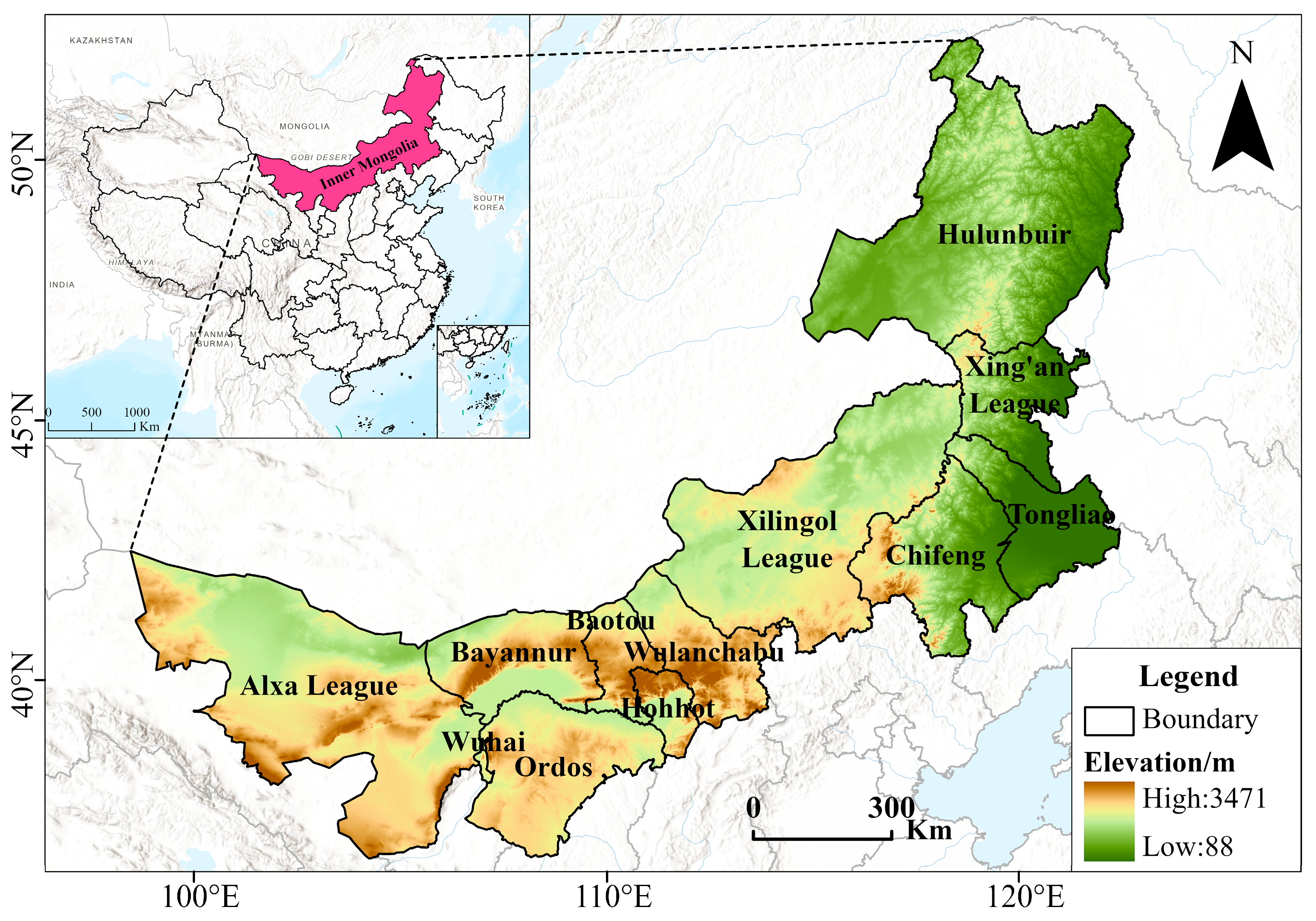
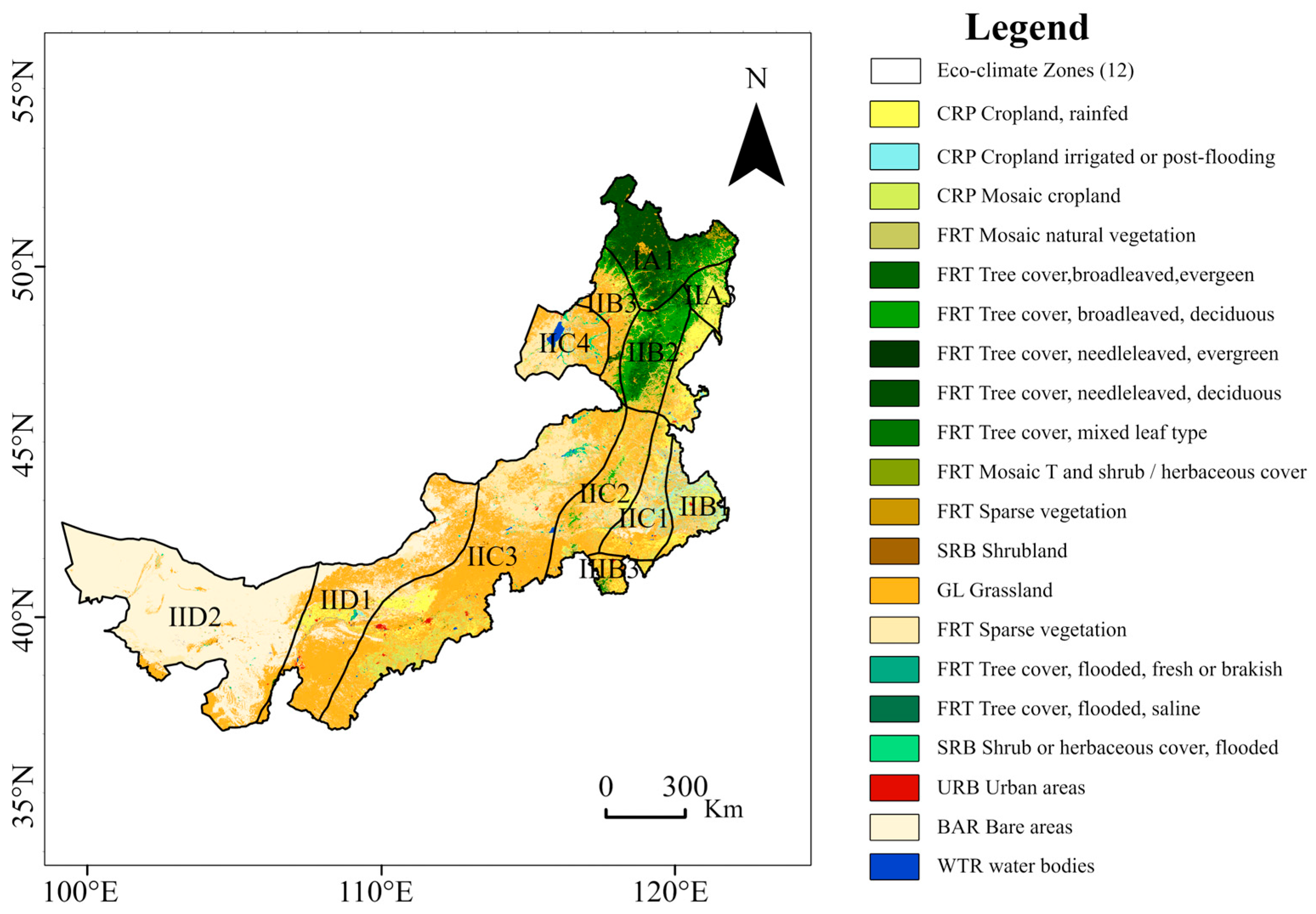
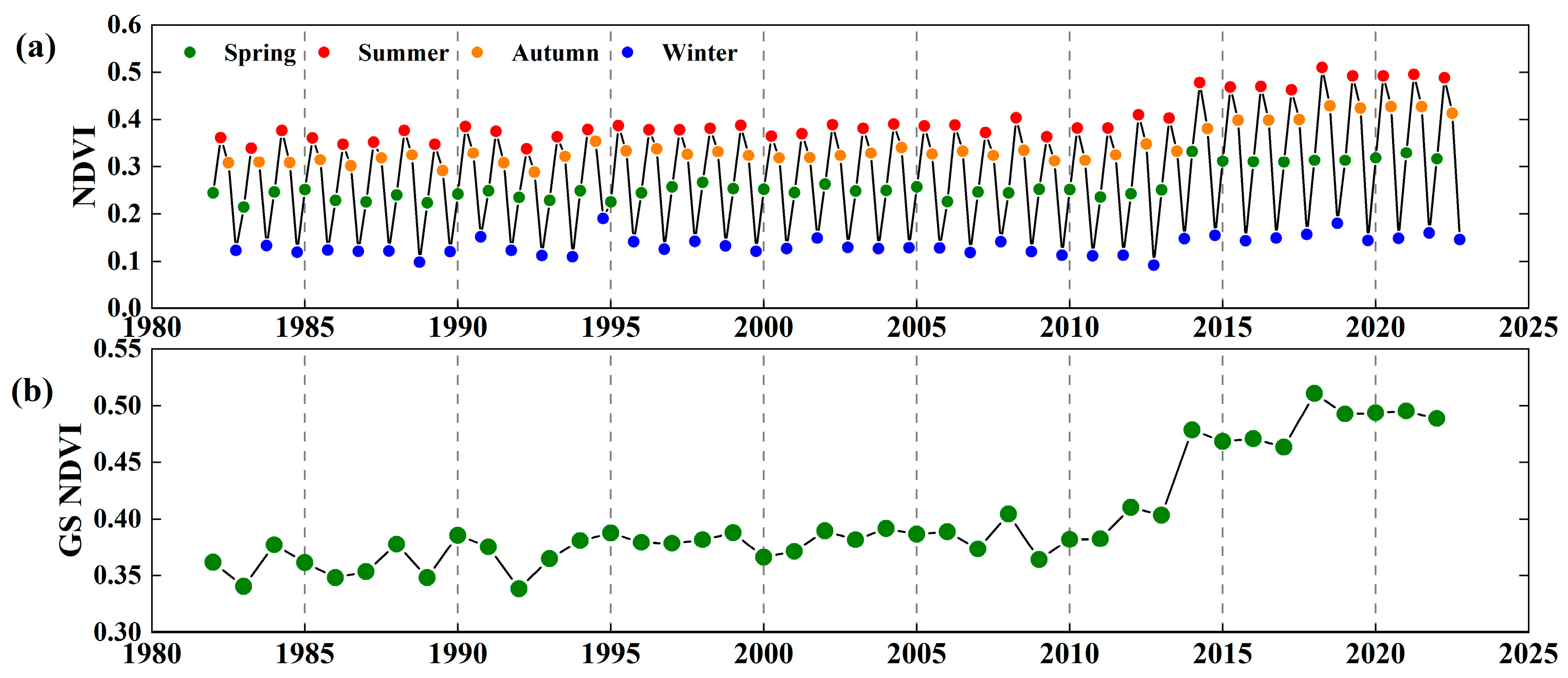
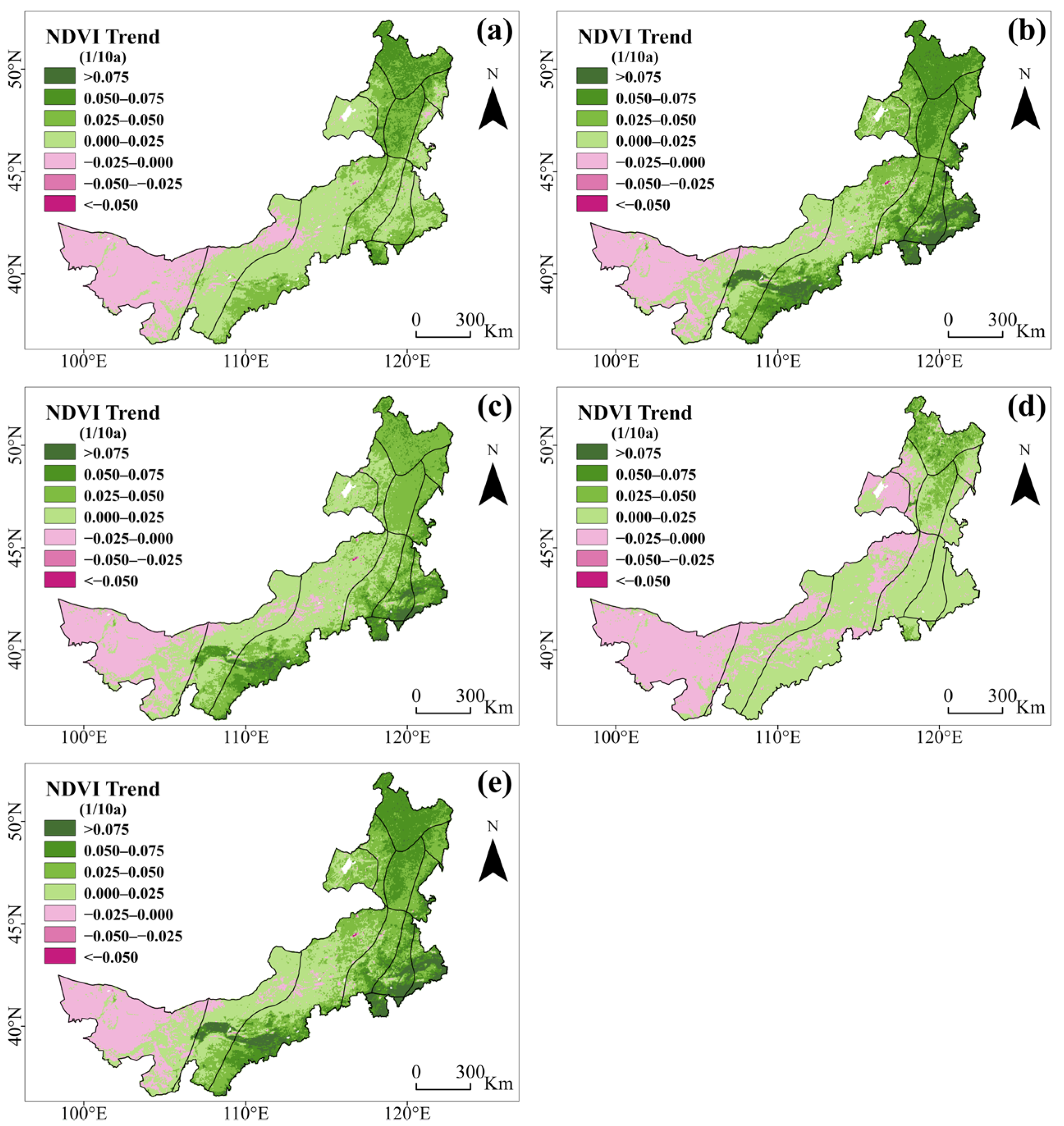

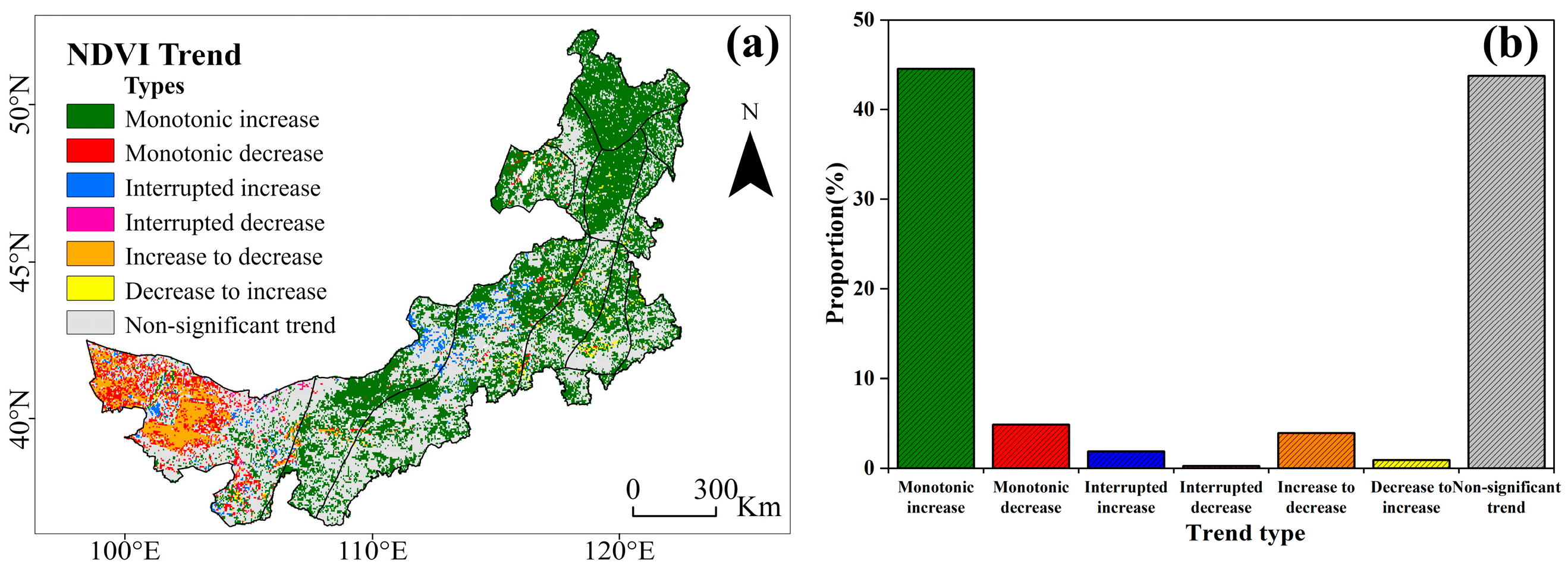

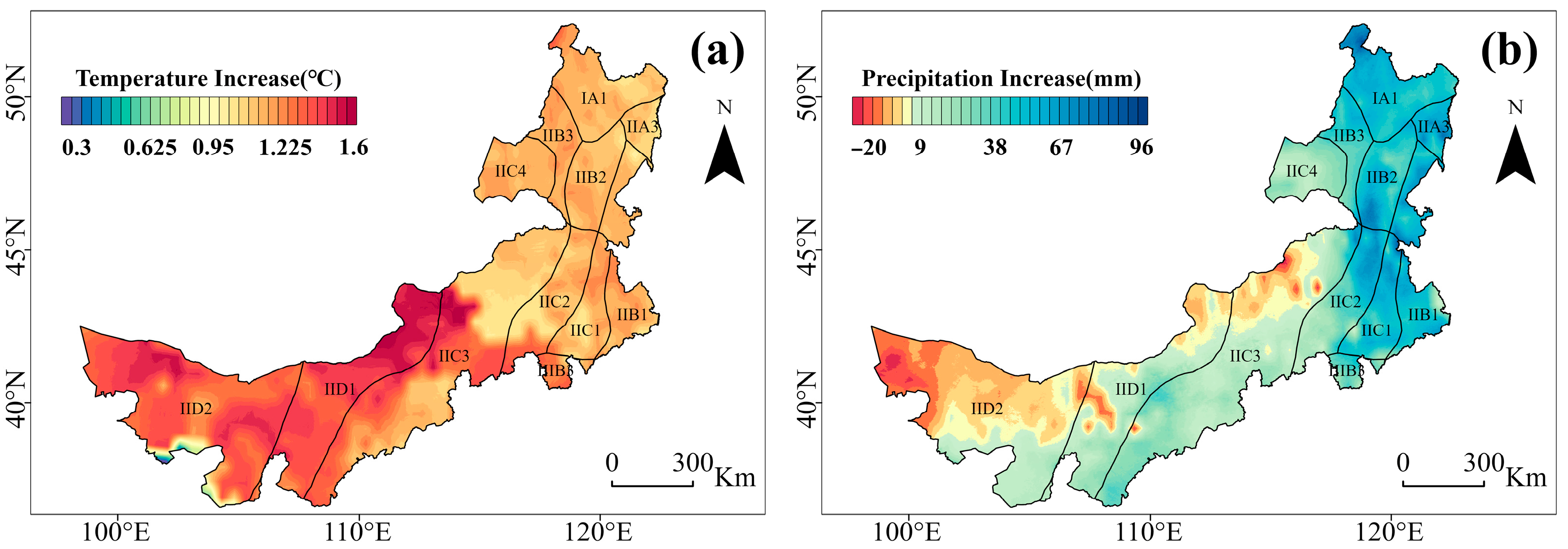



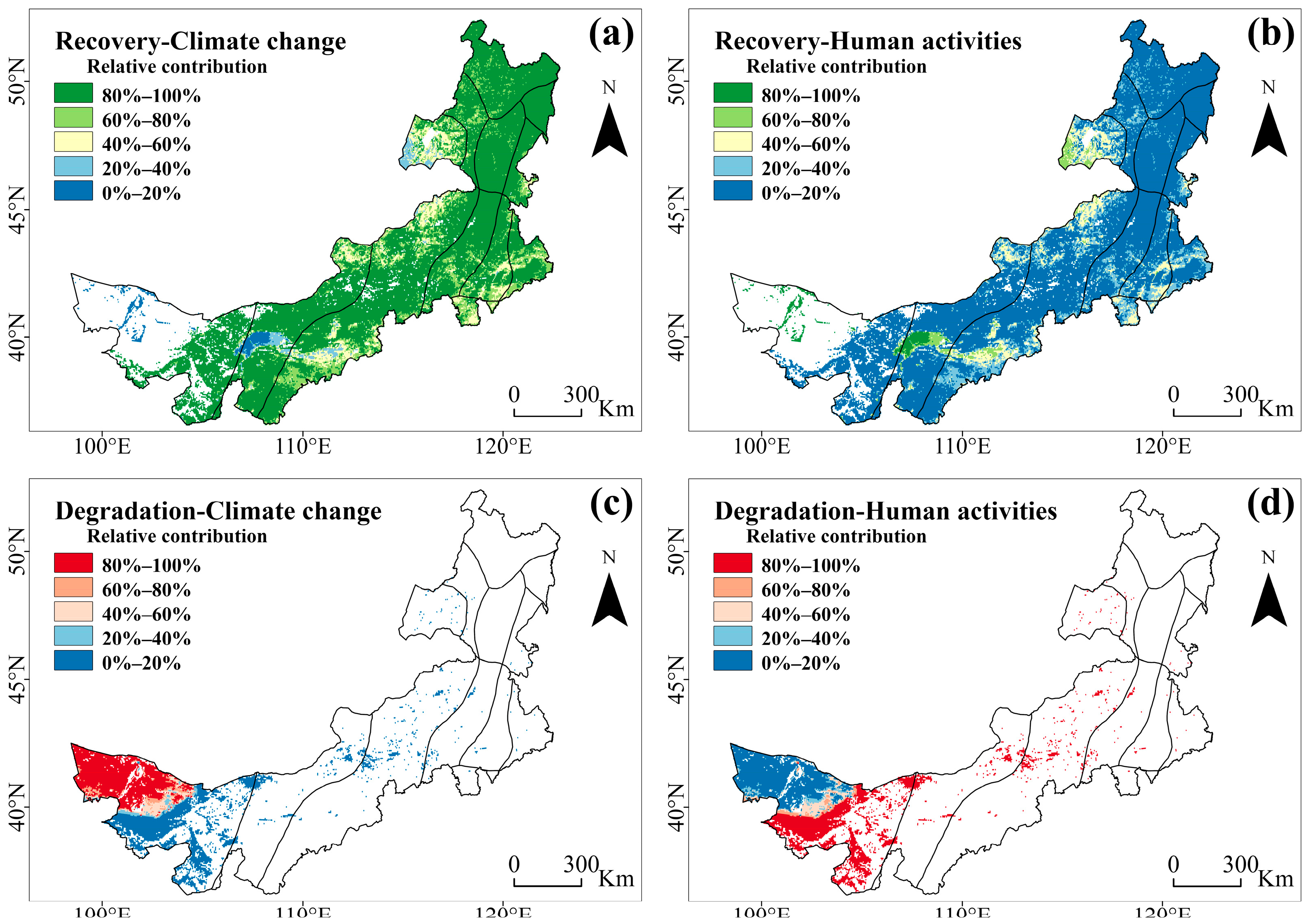

| Temperature Zone | Arid/Humid | Eco-Climate Zone |
|---|---|---|
| I Cold temperate zone | A Humid region | IA1 North Da Hinggan mountain deciduous coniferous forest region |
| II Medium temperate zone | A Humid region | IIA3 East of Northeast China piedmont platform broad-leaved and coniferous mixed forest |
| B Sub-humid region | IIB1 Middle Songhuajiang and Liaohe plain forest-steppe region | |
| IIB2 Middle Da Hinggan mountain steppe-forest region | ||
| IIB3 Hilly land of north part of west Da Hinggan mountain piedmont forest-steppe region | ||
| C Semi-arid region | IIC1 West Liaohe plain steppe region | |
| IIC2 West Liaohe plain steppe region | ||
| IIC3 East Inner Mongolia mid-altitude plain steppe region | ||
| IIC4 Hulun Buir plain steppe region | ||
| D Arid region | IID1 Hetao and west Inner Mongolia mid-altitude plain desert steppe region | |
| IID2 Alax and Hexi Corridor shrub and semi-shrub desert region | ||
| III Warm temperate zone | B Sub-humid region | IIIB3 North China mountain deciduous broad-leaved forest region |
| Type Name | Meaning |
|---|---|
| Monotonic increase | A significant increase with one significant break or none. |
| Monotonic decrease | A significant decrease with one significant break or none. |
| Interrupted increase | An increasing trend with a negative breakpoint. |
| Interrupted decrease | A decreasing trend with a positive breakpoint. |
| Increase to decrease | An increasing pattern disrupted and followed by a decreasing trend. |
| Decrease to increase | A decreasing pattern disrupted and followed by an increasing trend. |
| Non-significant trend | No breakpoint or both segments show no significant trend. |
| Slope (NDVIO) | Driving Factors | Driving Factors Classification Criteria | Contribution of Drivers (%) | ||
|---|---|---|---|---|---|
| Slope (NDVIP) | Slope (NDVIH) | Climate Change | Human Activities | ||
| >0 | P&H | >0 | >0 | ||
| P | >0 | <0 | 100 | 0 | |
| H | <0 | >0 | 0 | 100 | |
| <0 | P&H | <0 | <0 | ||
| P | <0 | >0 | 100 | 0 | |
| H | >0 | <0 | 0 | 100 | |
| Criterion | Interactive Forms |
|---|---|
| q(X1∩X2) < min(q(X1), q(X2)) | Weakened, non-linear |
| min(q(X1), q(X2)) < q(X1∩X2) < max(q(X1), q(X2)) | Weakened, single factor non-linear |
| q(X1∩X2) > max(q(X1), q(X2)) | Enhanced, double factors |
| q(X1∩X2) = q(X1) + q(X2) | Independent |
| q(X1∩X2) > q(X1) + q(X2) | Enhanced, non-linear |
Disclaimer/Publisher’s Note: The statements, opinions and data contained in all publications are solely those of the individual author(s) and contributor(s) and not of MDPI and/or the editor(s). MDPI and/or the editor(s) disclaim responsibility for any injury to people or property resulting from any ideas, methods, instructions or products referred to in the content. |
© 2025 by the authors. Licensee MDPI, Basel, Switzerland. This article is an open access article distributed under the terms and conditions of the Creative Commons Attribution (CC BY) license (https://creativecommons.org/licenses/by/4.0/).
Share and Cite
Guo, G.; Zou, X.; Zhang, Y. The Dual Effects of Climate Change and Human Activities on the Spatiotemporal Vegetation Dynamics in the Inner Mongolia Plateau from 1982 to 2022. Land 2025, 14, 1559. https://doi.org/10.3390/land14081559
Guo G, Zou X, Zhang Y. The Dual Effects of Climate Change and Human Activities on the Spatiotemporal Vegetation Dynamics in the Inner Mongolia Plateau from 1982 to 2022. Land. 2025; 14(8):1559. https://doi.org/10.3390/land14081559
Chicago/Turabian StyleGuo, Guangxue, Xiang Zou, and Yuting Zhang. 2025. "The Dual Effects of Climate Change and Human Activities on the Spatiotemporal Vegetation Dynamics in the Inner Mongolia Plateau from 1982 to 2022" Land 14, no. 8: 1559. https://doi.org/10.3390/land14081559
APA StyleGuo, G., Zou, X., & Zhang, Y. (2025). The Dual Effects of Climate Change and Human Activities on the Spatiotemporal Vegetation Dynamics in the Inner Mongolia Plateau from 1982 to 2022. Land, 14(8), 1559. https://doi.org/10.3390/land14081559





